1. Purpose of the experiment
1. Master the basic knowledge of watches.
2. Master the method of using Navicat or other third-party management tools and SQL statements to create tables.
3. Master the basic operation methods such as modifying, viewing, and deleting tables.
4. Master the definition of integrity constraints in tables.
5. Master the role of integrity constraints
2. Experimental content and requirements
1. Table definition and modification operations
Create a teacherInfo table in the schoolInfo database, the table structure is as follows:
2. Create the staffinfo database, and define the department table and worker table to complete the integrity constraints between the two tables.
| Structure of the Department table
The structure of the Worker table
|
3. Experimental methods and steps
1. Table definition and modification operations
(1) First create the database schoolInfo.
(2) Create teacherInfo table.
(3) Change the data type of the name field of the teacherInfo table to VARCHAR(30).
(4) Change the position of the birthday field to the front of the sex field.
(5) Rename the num field to t_id.
(6) Delete the address field of the teacherInfo table.
(7) Add a field named wages in the teacherInfo table, and the data type is FLOAT.
(8) Rename the teacherInfo table to teacherInfo_Info.
(9) Change the storage engine of the teacherInfo_ Info table to MyISAM type.
2. Create the staffinfo database, and define the department table and worker table to complete the integrity constraints between the two tables.
(1) Create a department table and a worker table under the staffinfo database.
(2) Delete the department table.
(3) Delete the department table
(4) Delete the foreign key constraint of the worker table
(5) Delete the department table again
4. Experimental results
1. Table definition and modification operations
(1) First create the database schoolInfo.
code:
create database schoolInfo;
result:
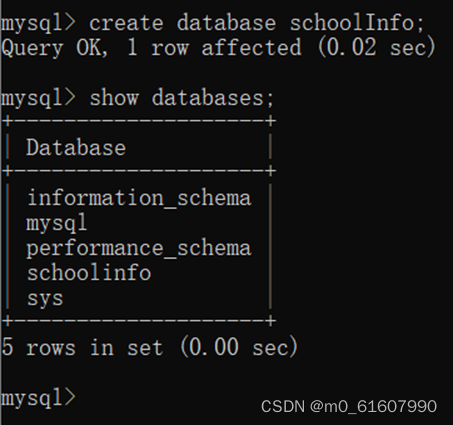
(2) Create teacherInfo table.
code:
create table teacherInfo (
id int(4) not null unique primary key auto_increment,
num int(10)not null,
name varchar(20) not null,
sex VARCHAR(4) not null,
birthday datetime,
address varchar(50)
);
result:
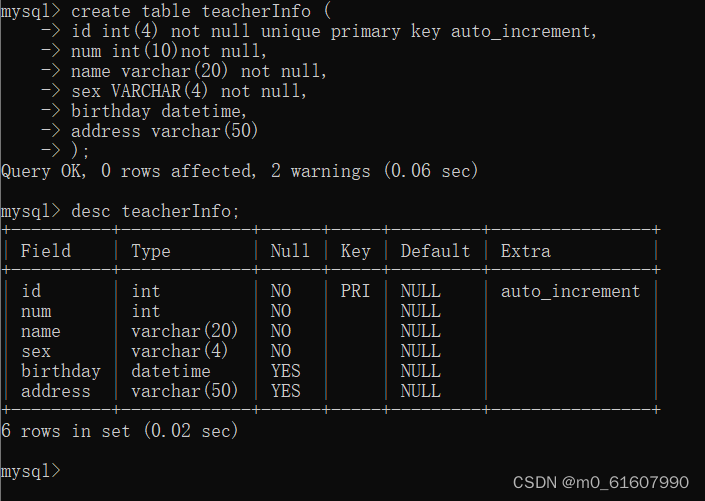
(3) Change the data type of the name field of the teacherInfo table to VARCHAR(30).
code:
alter table teacherInfo modify name varchar(30) not null;
result:
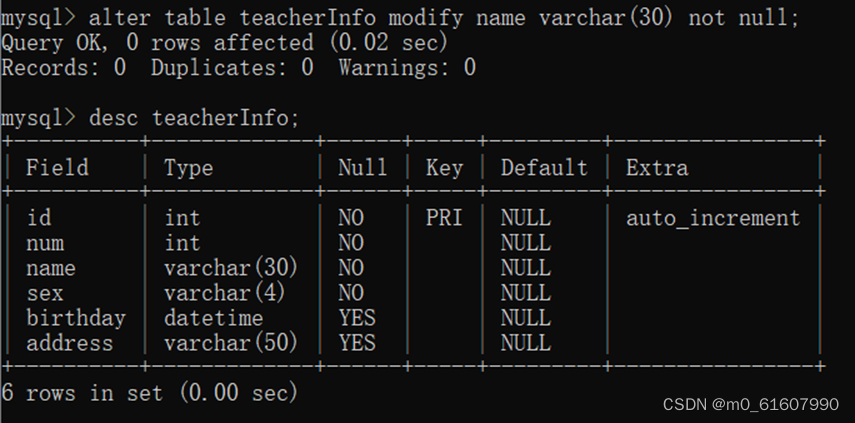
(4) Change the position of the birthday field to the front of the sex field.
code:
alter table teacherInfo modify birthday datetime after name;
result:
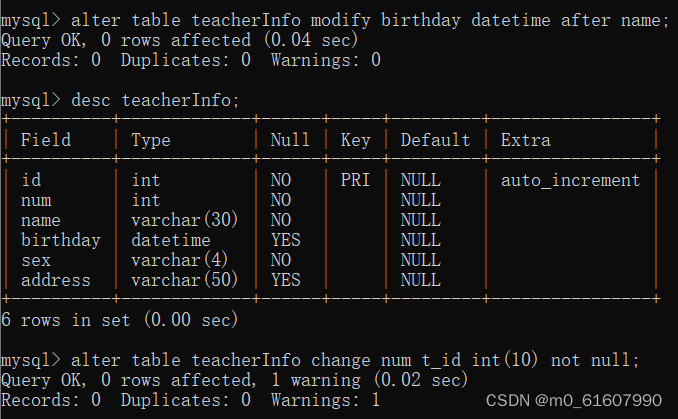
(5) Rename the num field to t_id.
code:
alter table teacherInfo change num t_id int(10) not null;
result:

(6) Delete the address field of the teacherInfo table.
code:
alter table teacherInfo drop address;
result:
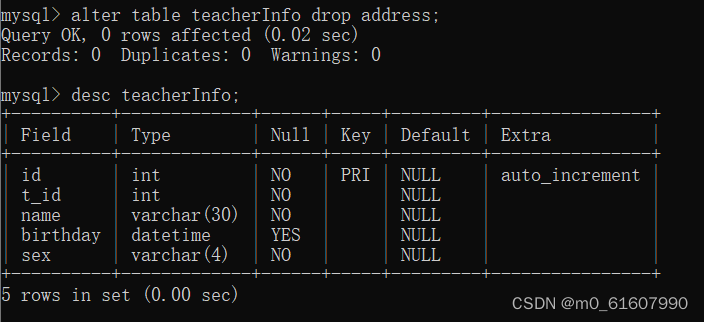
(7) Add a field named wages in the teacherInfo table, and the data type is FLOAT.
code:
alter table teacherInfo add wages float;
result:
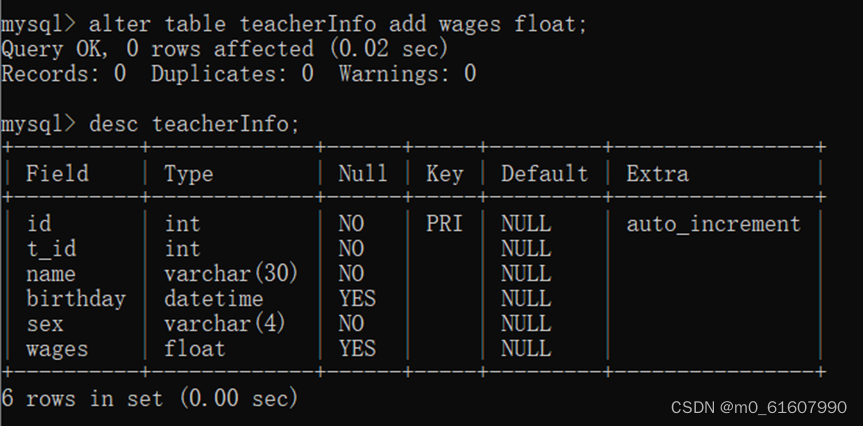
(8) Rename the teacherInfo table to teacherInfo_Info.
code:
alter table teacherInfo rename teacherInfo_Info;
result:
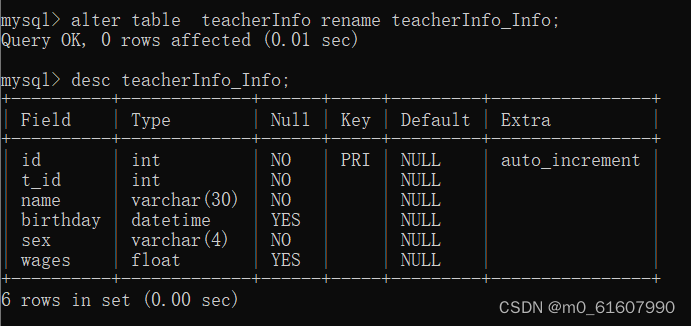
(9) Change the storage engine of the teacherInfo_ Info table to MyISAM type.
code:
alter table teacherInfo_Info engine = MyISAM;
result:

2. Create the staffinfo database, and define the department table and worker table to complete the integrity constraints between the two tables.
(1) Create a department table and a worker table under the staffinfo database.
code:
CREATE TABLE department(
d_id INT(4) NOT NULL UNIQUE PRIMARY KEY,
d_name VARCHAR(20) NOT NULL UNIQUE,
`function` VARCHAR(50),
address VARCHAR(50)
);
create table worker(
id int(4) not null unique primary key auto_increment,
num int(10) not null unique,
d_id int(4),
name varchar(20) not null,
sex varchar(4) not null,
birthday date,
address varchar(50)
);
result:

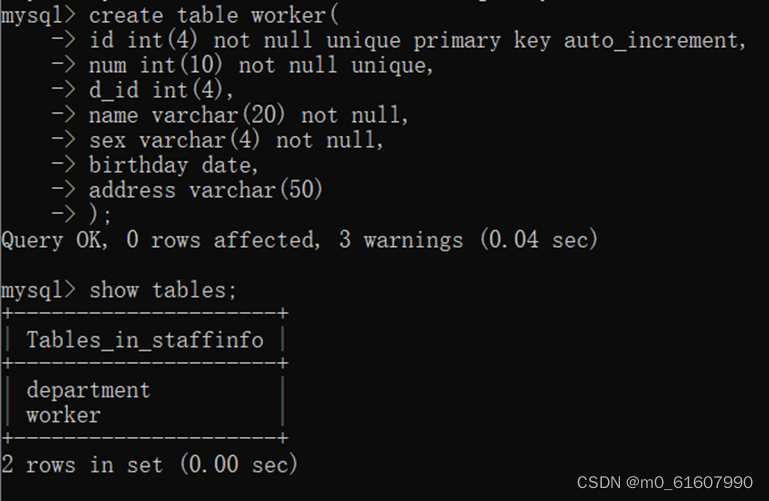
(2) Delete the department table.
code:
drop table department;
result:

(3) Delete the department table
code:
drop table department;
result:

Because the department table has been deleted before, the deletion fails again, and the unknown table is displayed
(4) Delete the foreign key constraint of the worker table
code:
Since the foreign key cannot be added directly when creating the table, here you need to add the foreign key after creating the table:
alter table worker add constraint d_id foreign key(d_id) references department (d_id);
worker is the name of the slave table
d_id is 1 foreign key constraint name
department is the main table name
alter table worker drop foreign key d_id;
result:

(5) Delete the department table again
code:
drop table department;
result:

5. Summary of Knowledge Points
Table integrity constraints include:
primary key #Identifies the field as the primary key of the table, which can uniquely identify the record
foreign key #Identifies the field as the foreign key of the table
not null # indicates that the field cannot be empty and must be assigned a value
unique key # identifies that the field is unique
auto_increment #Identifies the automatic growth of the value of the field (integer type, and primary key)
default # Set a default value for this field, and use the default value without assigning a value to the field when inserting a record
unsigned # unsigned (sign, etc.)
zerofill # fill with 0